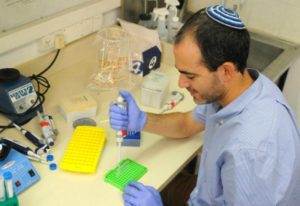By Larry Luxner
JERUSALEM — When Asael Lubotzky led his soldiers into battle against Hezbollah 12 years ago during the Second Lebanon War, he knew he might be wounded or even killed.
What the infantry platoon commander never could have imagined was that a crippling injury would catapult him into becoming a bestselling author — and, eventually, a physician.
Despite suffering wounds in Lebanon that nearly cost him his life, Lubotzky is now a cancer researcher. His work focuses on epigenetics: designing new methods for early diagnosis and treatment of cancer based on blood tests.
Lubotzky says the 2006 battle at Bint Jbeil — just two miles north of the Israel-Lebanon border — changed his destiny.
“It was Aug. 9, 2006 — the 15th of Av,” recalled Lubotzky, 35, who still needs the aid of crutches to walk.
“I was talking on the radio, trying to help my guys navigate. I opened the hatch and lifted my upper body out in order to see better. Just then, an anti-tank missile fired by Hezbollah hit my vehicle. If I had been sitting at that moment, I wouldn’t be here today.”
That miracle, which Lubotzky attributes to his deep faith in G-d (he had donned tefilin that morning, as he does every day), was the first of many that enabled him not only to avoid the amputation of his severed right leg, but later to marry, have four children and realize his post-traumatic dream of becoming a doctor.
Today Lubotzky is an MD completing his doctorate at The Hebrew University, where he shares a lab with 10 other researchers.
After his injury, the Jerusalem-born Lubotzky, who grew up in the West Bank settlement of Efrat, decided he wanted to tell the dramatic story of his recovery in a book. What became his 190-page autobiography began as a story of the battle that nearly killed him.
“I started writing because of all those long days laying in the hospital trying to remember the events,” Lubotzky said.
“Many of my fellow comrades came to visit me, and we spoke about combat. I began writing a technical diary, with dates and what we did. As time went on, I elaborated and wrote more about what I felt. Later on, I decided to write about the rehabilitation process.”
In the 10 years since its publication, Lubotzky’s book, From the Wilderness to Lebanon, has sold nearly 20,000 copies in Hebrew and has been translated into English.
His second book, Not My Last Journey, came out last year and documents the life of his grandfather, the partisan and Irgun officer Iser Lubotzky.
In another twist to his story, the mother of the doctor whom Lubotzky credits with saving his leg had been a nurse with a group of partisans in Europe fighting Nazis when she treated a man with a terrible leg wound — Lubotzky’s grandfather.
Inspired by the doctors who treated him during his recovery, Lubotzky turned his sights to medicine.
He eventually decided he wanted to focus on research, and recently joined the lab of Yuval Dor, a professor at Hebrew University’s Dept. of Developmental Biology and Cancer Research.
He plans on finishing his residency next year in pediatrics at Jerusalem’s Shaare Zedek Medical Center, and to specialize in neurology and genetics.
In early July, the Israel Cancer Research Fund awarded Lubotzky a two-year research grant worth $50,000.
Lubotzky’s research is focused on the links between DNA and cancer. When a cell dies, it often releases short DNA fragments into the blood known as circulating cell-free DNA, or cfDNA.
Doctors have begun using liquid biopsies to sequence the cfDNA in the plasma and use the results as a diagnostic tool to detect such issues as fetal chromosomal aberrations, hidden tumors and graft rejection in solid organ transplants.
By looking for specific epigenetic marks carried by circulating cfDNA, scientists can make early diagnoses of various forms of cancer.
For example, if a man has cancer, examining the circulating cell-free DNA along with the epigenetic marks in his blood may reveal and locate the primary tumor or metastatic tissue of origin.
“By sequencing those DNA fragments and epigenetic marks, we can infer the rate of cell death from various tissues,” Lubotzky said. “You can also perhaps track response to treatments from circulating cfDNA from tumors.”
Nobody else in Israel is pursuing this line of research, says Lubotzky, though labs in other countries are doing similar research.
“Here I have the combination of a very advanced molecular biology lab with clinical skills,” he said. “Though we work on different issues, we speak about the diseases of patients. We work on humans, not mice.”
While trying to help others, Lubotzky still contends with physical pain stemming from his war injury. He underwent intense physical therapy in the early years after his injury, and today he’s careful to swim almost every morning — before heading off to morning prayers.
“My body has to overcome lots of pressures that healthy people don’t have to overcome,” he said.
“When I’m more active and do more sports and hold my kids in my arms, I think less about the pain.
“Yes, it’s something that’s going to be with me my entire life,”he said. “But I’ve found ways to overcome it.”

















